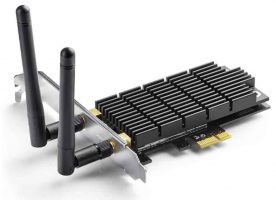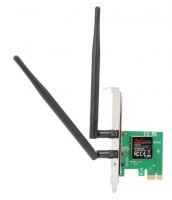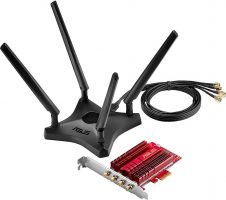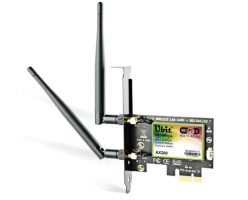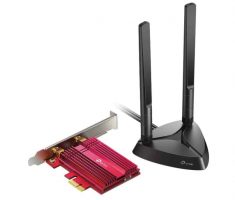Best PCI-e Wifi Card in 2021
Five Awesome PCI-e Wifi Cards for Welcoming Your Build to the Wireless World
- Last Updated Jun 15, 2021
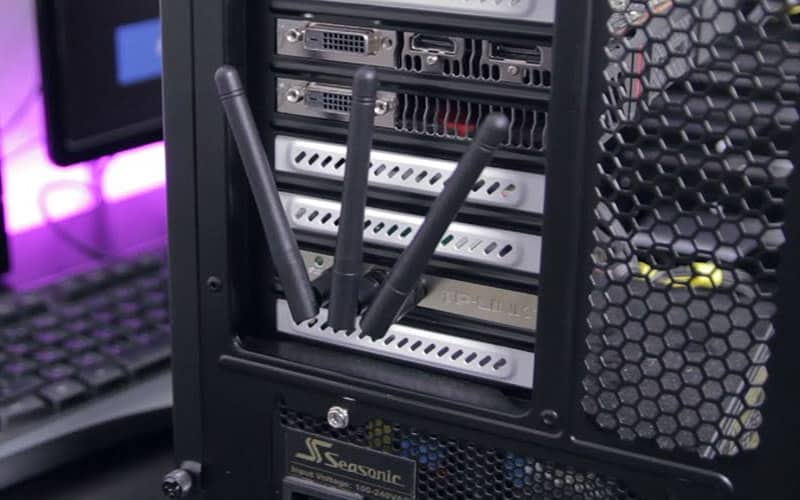
A PCI-e wifi card is a simple enough concept. Hook one of them up to your motherboard and voilà! You have a wireless connection that you didn’t beforehand. But the particulars of a wifi card’s abilities are a little more complicated.
It’s frightfully easy to pick up one that doesn’t actually cater to any of your needs, and then you’re out of pocket, and you still don’t have a wireless connection…what luck, ay?
Not to worry though, friend. If we have anything to say about it, you’ll never have to go without a wifi connection ever again. Having put up with a lifetime of squiffy wireless connections here at pcguides, we’ve picked up a thing or two about quality PCI-e wifi cards, and we’re going to share our absolute favorites with you right now!
Let’s not draw things out any longer than necessary. You’ve already been starved of wifi for god knows how long, you poor soul, so we’re jumping straight into the reviews.
Products at a Glance
Best PCI-e Wifi Card in 2021
Hardware Interface: Express Card, Radio Frequency
Operating System: Windows 10/8.1/8/7 (64/32bit)
Data Link Protocol: IEEE 802.11a
Data Transfer Rate: 1300 Megabits Per Second
Item Weight: 0.6 Pounds
876 and 400MBps Connection Speed – Speedy connection eliminates lag.
Extended Range – Gives you greater freedom of movement.
Bulky Heat Sink – Increases connection stability.
Price – It’s a great value for money card.
Antennas – We’d prefer a greater range extension.
TP-Link is a well-established player in the networking industry, and the Archer T6E is one of their most brilliant creations. Featuring 876MBps in the 5GHz band and 400MBps in the 2.4GHz band, this insectile little fella is more than capable of supporting long-scale streaming, and gaming in resolutions up to 4K.
Looking at the Archer, the first thing you’ll notice is that beefy heat sink ensuring the cores remain cool and in control when you’re pushing your connection with some high-resolution, online, multiplayer gaming. With this thing hooked up to your motherboard, you’ll never be able to blame lag for your defeat ever again.
The antennas could definitely be improved, but they do offer a fair bit of range, so you can wander further from your router and still enjoy a speedy, stable connection.
Compatible with pretty much every Windows operating system still in use, it should help most builds find a secure signal, but unfortunately, it’s not primed for Linux. Besides that, this is a fantastic value for money wifi card that competes at the highest levels of the industry.
Hardware Interface: PCI
Data Link Protocol: IEEE 802.11b, IEEE 802.11n
Data Transfer Rate: 300 Megabits Per Second
Frequency Band: 2.4 GHz – 2.484 GHz
Channels: 1 CH (US, Canada), 13 CH (EU), 14 CH (Japan)
Price – Reliable wifi for less than $20!
Discrete – Doesn’t stick out like a sore thumb.
External Antennas – Feel free to set up shop far away from your router.
300Mps – Not the fastest connection in the world.
No Thermal Solution – May get hot when pushed which will destabilize connection.
If you’re looking for something a little more discreet than the chunky Archer 1300, this Rosewill N300 will definitely hit the spot. Creating a secure single that facilitates upload/download speeds of 300MBps, it’s the perfect compact wifi card for casual gaming, flawless zoom calls, and buttery smooth streaming.
Much like the Archer, it comes with two detachable antennas that significantly improve signal range, so say goodbye to that router; you may not see it for some time.
It’s designed for use with Windows operating systems XP through 10, so it should slot right into your build and kick straight into action.
When it comes to applications that require a completely steadfast signal such as competitive gaming, we wouldn’t rely solely on the N300. Lacking any advanced thermal solution, it’s not as stable as some other options on the market, but for a budget solution for day-to-day computing, it can’t be beaten.
2100 and 1000MBps – One of the fastest cards on the market.
Quad MU-MIMO – supports four individual wifi connections.
Low Profile Bracket – This makes installation on SFF builds a breeze.
Long Range – You could probably pick up this thing’s signal on the moon.
Impressive Heat Sink – Can handle heavy usage without destabilizing.
Price – You’ve probably guessed by now that this doesn’t come cheap.
Compatibility – You’ll need a 64-bit operating system.
The PCE-AC88 is a dauntless wifi beast capable of pushing out connection speeds as high as 2100MBps on the 5GHz band and 1000GBps on the 2.4Ghz band. To explain how impressive that is, let’s put it into a bit of context. 100MBps is typically considered a decent speed for online gaming. On its highest band, this wifi card provides over 20 times that connection speed.
Not only does it feature four fantastic, range-boosting external antennas, you can use the R-SMA connectors to hook up an even more powerful set of aftermarket antennas. The included antennas can attach directly to the card, or they can be wired in, giving you more options in terms of placement and coverage.
The AC88 also has quad MU-MIMO connectivity, so you and three other cohabitants can all enjoy individual communication with the router, amounting to smooth, secure signals all round.
Fitted with an impressive red heat sink, the AC88 handles itself incredibly well, making it perfect for high traffic, data-heavy applications. Despite this, as it’s such a high-powered card, it can run pretty hot, so we recommend keeping ambient and case temperature at a minimum.
Connectivity Technology : Wireless
Bluetooth: 5.2
Operating Systems: Microsoft Windows 10 64-Bit, Linux, Chrome OS
Encryption: 64-bit and 128-bit WEP, TKIP, 128-bit AES-CCMP, 256-bit AES-GCMP
Processor Brand: Intel
2402 and 574MBps Connection Speeds – Faster than you’d ever really need.
Bluetooth 5.1 – Extremely low latency communication between computer and wireless peripherals.
OFDMA – Speed up network interaction of multiple connections.
Price – Pretty sweet price tag for a wifi 6 card.
Range – Dual external antennas provide pretty decent range.
No Thermal Solution – You’ll have to prioritize the AX when it comes to cooling.
The Ubit AX may look like it’s not up to much, but make no mistake, this diminutive dynamo packs one hell of a punch! Firstly, this is a wifi 6 device, which means it’s capable of much higher speeds than previous generations. How fast is it? How does 2402MBps sound? And that’s just on the 5GHz band. It offers a further 574MBps on the 2.4GHz band
Moreover, it has Bluetooth 5.1 connectivity ensuring that not just your PC has solid access to the network, but your wireless peripherals such as headphones, keyboards, mice…etc, all benefit from the ultra-fast connection speeds.
It doesn’t feature MU-MIMO connectivity, but it does offer something called OFDMA which helps to smooth out low bandwidth usage across multiple connections.
Although the AX is designed to provide seamless connectivity during data-heavy workflows, it doesn’t come with any sort of integrated heat sink, so we highly recommend taking your own measures to keep it cool.
Operating System: Operating System: Supports Windows 10 (64-bit) only
Hardware Interface: Bluetooth
Data Link Protocol: Bluetooth
Data Transfer Rate: 2400 Gigabits Per Second
Item Weight: 1 Pounds
Wifi 6 – Fastest connection speeds we humans have mustered yet.
Separate Antenna Stand – Saturate a greater area with wifi signal.
Bluetooth 5 – Uber-fast data transfer between computer and peripherals.
MU-MIMO and OFDMA – Simultaneous connections are guaranteed to be fast and stable.
Dedicated Heat Sink – This thing handles heat incredibly well.
Price – More expensive than the AX.
Things To Consider
FAQs
Our Verdict
Hardware Interface: Express Card, Radio Frequency
Operating System: Windows 10/8.1/8/7 (64/32bit)
Data Link Protocol: IEEE 802.11a
Data Transfer Rate: 1300 Megabits Per Second
Item Weight: 0.6 Pounds
Breathe a big sigh of relief, friend. Your wifi woes are a thing of the past. With one of these awesome devices making themselves at home in your motherboard, unless you stop paying your bills, you’ll never be without stable wifi again.
We hope that this article has answered some of your wifi card-related questions and shed a little light on the technical aspects of their performance and compatibility.
As long as you use our buyer’s guide to help you decide what sort of PCI-e wifi card would work best in your situation, you’re all set to make your purchase!

